Kathryn Schwartz Feature
Thursday, February 7, 2008
by Tim Doll
If one was heading up I-75 towards Troy, Ohio looking for Society Training Stables on Rusk Road one might think for a moment that they had gotten off the beaten path. If you start running out of telephone poles and cornfields you’re almost there. When suddenly, situated upon a hill, lies the facility you’re looking for.
Spanning 40 acres complete with an 1850 circa Civil War home is where you’ll find owner Kathryn Schwartz. The complete facility is comprised of a well equipped training barn, a separate blacksmith and hay storage barn, paddocks, pastures, bull pens; about as complete an operation as anyone could ask for.
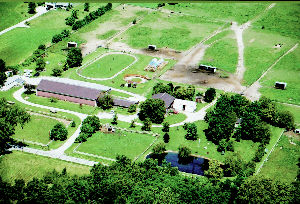
Society Training Stables and Farm
Like most Morgan trainers, or any other trainer for that matter, Schwartz pretty much spends her day training her horses and helping to keep the operation running as smoothly as possible. She spends a great deal of her time during the spring, summer and fall going to horse shows across the country, but also keeps busy when it’s time to bring those equine babies into the world.
Perhaps you will also note that her farm consists of a huge menagerie of animals. One might think of Old MacDonald’s Farm upon his introduction to the farm. There are a wide variety of dog breeds, mostly pets, some running free, others not. A varied assortment of goats, peacocks, chickens, cats, ducks, llamas, various horses of other breeds and the list goes on and on. It soon becomes vary obvious that Schwartz is an avid lover of all animals.
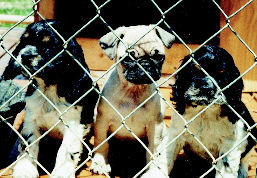
These puppies are just a small part of
the menagerie of animals on the farm.
Amidst all this there are actually horses in training. Although she has room for many more Morgans than she has in training, she has cut down to a comfortable number of 12 to 13, primarily due to the lack of good dependable help. Even though training itself keeps her pretty busy, Schwartz said, “I will always find the time to play with my animals and spend time with them. That’s a big part of who I am. I have always loved animals of all kinds.”
Even for those who know her and for those who don’t, you find her quiet, shy, unassuming, yet sincerely honest. If you don’t want a straight from the hip honest answer, don’t ask her. Yet, she is friendly, loves to laugh and likes a good joke as anyone would.
Schwartz has always been a very hard worker. In fact that is what has got her this far. She is very hands on and driven by success and determination, as is evident when she arrives home from a horse show with several ribbons, trophies and tricolors, which she has worked hard to earn for herself as well as her customers.
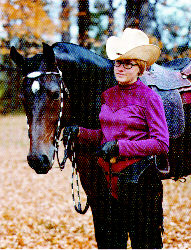
Schwartz pictured with her first Grand
National Champion, Susie Success, at
the Grand National held in Detroit, Mich.
“There are always obstacles both in life and in the horse business as well, but you just have to deal with it, put one foot in front of the other and make tomorrow a better day. There will be times when we come home from a show and the fruits of our labors have not been what we had hoped but we move on,” said Schwartz.
“If a person sailed throughout life uninterrupted it would be pretty boring. I think sometimes all of us need a shot in the arm, a reality check every once in a while. I have been blessed over my many years in the Morgan business to have had the good fortune to have wonderful customers. Occasionally you will get one that is a little hard to get along with but by far the good ones outweigh the bad ones. Well, I really wouldn’t even call them ‘bad’ ones, perhaps a little difficult.”
Schwartz works hard to keep her customers in a good place, enjoying what they are doing and educating them along the way. Back in her home state of Wisconsin growing up, she was raised mostly around Arabian horses as her mother, Esther, was heavily involved with them on their dairy and swine farm.
Schwartz will readily admit that school was not her thing. She would ride the school bus an hour each way to get to school. “I would much rather get home from school and get on a horse,” said Schwartz. “I loved endurance horses back then, still do, but as age creeps up on you, one soon begins to get a little stiffer and the joints don’t react as they used to, at least mine don’t.”
Schwartz was not alone growing up. She had two brothers, Steve and Dick, and two sisters, Heidi and Diane. The brothers didn’t become too involved with the horses but the sisters rode some. Her father, Dwayne, pretty much ran the farm operation, getting help from the whole family when needed.
When Schwartz finished school, she immediately went to work for her aunt, Doris Martin. She worked for her for about two years. She then proceeded to work for Carolyn Gardner in Illinois for a very short time.
“She was extremely hard to work for. Pretty tough!” Schwartz said. She then headed for Downer Hill Morgans. Some of the horses she worked with there included Shaker’s Rio, Big Bend May Moon, Downer Hill Elena and Figure’s Donnabrook.
After that job she then headed to Kohler Stables where she worked for J.T. Brown who was then trainer. She really enjoyed her job there and some the horses they had at that time were Sugar Run Moonlark, Susie Success, Irish Lane and Shaker’s Bolero.
“Once I pretty much got away from being involved with the Arabians I found out instantly that I really loved the Morgans and the people. It’s a good industry to be involved with.
“Once I ventured ahead, I went to work for Jack White in White House, Ohio,” Schwartz continued. “I worked at Jack’s for three or four years. We had Society’s Super Sport, Morgana’s Westwood and my boy, Whit-Aker’s Sensation. He was by Troutbrook Playboy and out of Shaker’s Gaiety. He was part of that good old Shaker Hill breeding.”
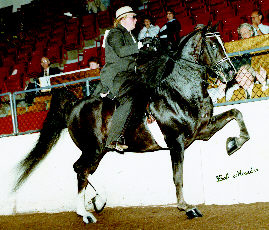
Morgana’s Westwood garnered 10 world and
national championships during his career.
After Jack White passed away, Schwartz then headed to where she has now called home for 21 years, Rusk Road in Troy, Ohio, northeast of Dayton. She acquired the farm through information from a friend who at the time boarded her horse there. She worked out a deal with then owner Gladys Whittmer, and eventually Schwartz had a place to call home.
When asked what it was in particular about Morgans that she liked, she said, “They are so versatile. If they don’t work in one division they are useful enough to go into another one. I really like that. That was one thing I didn’t notice in the Arabian world.
“Because of the usefulness of the Morgan and their versatility I do believe that in part that may be the reason why our pleasure divisions are so big. They drop down park horses and others from various divisions and thus comes the influx. I think that’s great. Pleasure horses are so adaptable to people, they just seem to click. They take a good amount of training like any horse in any division but these pleasure horses just seem to function well with the masses. They are also taking giant steps in the Saddlebred world.”
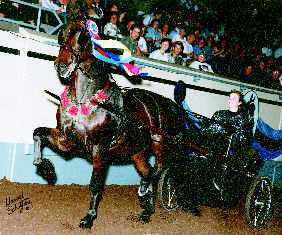
Checkmate Cantor and Christy Swindell won the
Jr Exhibitor Pleasure Driving World Championship
under the direction of Schwartz.
Schwartz continues, “I do have to comment here. I work with western pleasure horses and find that I really have to take a lot of time with them. If they have a problem like chomping (chewing the bit) or getting their tongues over the bit, and so on. The rule restrictions make it almost impossible to correct these problems and at the same time show them to their best ability. I know now that we can use bands on the hoof for those horses that have bad feet, so I do have to wonder why we can’t use a tongue tie or caveson to help with the other problems with our western horses, among others. That rule has always bothered me a little.”
When asked how she felt the Morgans of earlier years compared to the Morgans of today, Schwartz answered, “They are bigger, stretchier, a little away from type, some of them. I don’t think we ought to do that. Nor do I want our breed to look like miniature Percherons. I think you can get a little saddley looking. But I do admit they sure are pretty.
“They also seem to be a little more fine tuned. Perhaps that is the progression of the industry. Not at all a bad thing. I always felt even the best needed fine tuning as time progresses and the industry calls for advancement. It’s a new look if you will. And face it; competition is tough, really tough.”
Speaking of tough competition, Schwartz explained how she dealt with a difficult horse. “I believe there are some horses you have to be tough right back with. I don’t mean in any way hurt or mistreat them, but in my barn there is only one boss and that is me. I don’t give any days off school for bad behavior. I think we both learn from those experiences, and that’s good. When I stop learning or being effective as a trainer, it’s time to change course. I might change up the pace, drive instead of jog, long line instead of ride or vice versa. I always attempt to keep the training fresh. Some horses thrive on the same type training day after day but even at that I still sometimes change up the pace. Change is good.”
Schwartz like many trainers also gets involved with the breeding portion of the industry. Regardless of the breed, there sometimes seems to be a consistency of horses with weak back ends.
“If you have a stallion that is pretty good off his back end (hocks) like Whit-Aker’s Sensation was and you breed him to a mare with a weak back end that in no way guarantees that the offspring will have a strong back end,” Schwartz said, explaining her philosophy on breeding. “No doubt there may be crosses that the back end gets stronger with the offspring, but then again not. There is no guarantee. I do think we have gotten strong back ends from our breed but we still have a long way to go.
“Sometimes a back end is so weak that it is hard to know if they are trotting or not. I have judged some horses where that was the question. I know after Sensation won the World Park Saddle we booked 51 mares to him. I’m not sure, but I don’t believe we bred a single park mare. Some of his get were pretty good off their back ends but then some were not. It is something that may never fix itself. I do believe that if you stand a stallion and own a lot of broodmares and breed them consistently year after year and don’t work to improve on the faults then to me we’re wasting our time.”
In about all classes a balanced trot is one particular thing a judge looks for. The key is performance. Any performance even on Broadway can be improved upon with the right planning, forethought and education. The horse industry and its counterparts are certainly no exception to improving on quality as well as performance.
Because of her quiet demeanor, don’t think for a moment that Schwartz doesn’t have a competitive spirit. It may seem quiet but it definitely is not. Schwartz has that strong desire to get the job done and done right. “I may be getting older, aches and pains here and there, but I think that competitiveness comes from within. I don’t think its something instilled in you. I believe we are born with it. It makes us who we are. I love to compete on any level and sometimes it may come down on me like a hammer. My spirit tells me to go on even if my body says take a break.
“I think being competitive is a vital part of any trainer. I absolutely love for my horses to be that way. I always try to keep them in that spirit also. However, it really doesn’t matter to me if I get a ready-made horse, which no doubt will need re-tuning some, or one I raise from a baby. To keep them with that edge you have to handle them properly. I believe that handling any horse properly regardless of age is key. Improper handling can do more to take away that spirit, that competitiveness, than anything else.”
Schwartz reflected back on some of her early influences. “Several years ago I thought Carrousel gave a big shot in the arm for our industry. They were to reckon with. The late Bob and Judy Whitney (Harris) were unbelievable as well. I believe they garnered over 200 world and national championships. That’s unheard of.
“I used to sit in the stands and watch trainers working their horses after a show or even during the classes they were competing in. It was a great learning experience for me. It has helped me grow as a trainer. It hasn’t changed who I am, but I feel I have taken bits and pieces from other trainers and intertwined that with my ways and here I am.”
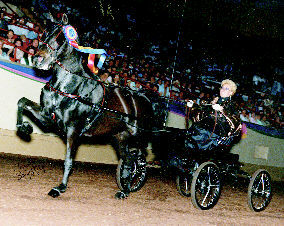
Schwartz and multi-titled Brentwood Bracelet
In years gone by, according to Schwartz, there have been people who put her down, constantly ridiculing her for whatever reason or told her she didn’t have what it took. “You begin to come out of your shell,” Schwartz said. “You start to get a little hard on yourself, it changes you for better or worse, depending on the person, but in my case it has helped me grow, gathered my values and strengthened me. Don’t ever tell me I can’t do something. That ignites a fire in me to prove them wrong, and I have and I will continue to do so.
“I think it is so important that these younger trainers coming up today get all the positive feedback, necessary direction and help from their peers when needed or asked for. They are the future of our industry. For example, among several, Tim Roesink has a tremendous show string. He is also very talented. His dad, Ron, brought him up the right way, involved with horses and teaching him along the way. Another is Jaisen von Ballmoos. He is another young trainer who is commanding some attention. Also Katie Mair is commanding her own attention. Proper guidance will propel these young men and women, as well as many others making their presence known, that the future will be entrusted to them. Encourage them!”
In keeping with the regards to trainers, Schwartz added which seasoned trainers have caught her eye. “I think Tommy Caisse is one of the best trainers of any breed across the United States. No specific division, he just seems to have that special something with a horse, a special connection. This man can walk into his barn, and I’m serious, the horses stand at attention. He gets their attention immediately. I think that is uncanny!”
Speaking of getting attention, Schwartz also added her two cents on how the industry needs to attract more attention. “We need to do far more than we are doing. Showing in front of ourselves is not good for the breed, any breed. There are promotional things out there that are working to some degree. We need to reach a far greater audience. I think the Symphony of Horses held during the UPHA Chapter 14 Spring Premiere Horse Show in West Springfield, Mass., is a prime example of getting our horses seen by the general public and other breed audiences. It’s exciting, glamorous, and the stars participating in this event are world and national champion caliber.
“Another avenue is our open shows. I try to go to as many with my customers as they will allow to get them used to seeing other audiences and vice versa. Then let the people in the stands grab on to a particular breed or breeds that attracts their attention and fits their lifestyle. I don’t think there are many shows that have literature available at shows that could be inserted into programs and a space available for breeds to have literature for spectators to pick up. What do we have to lose?
There are trainers that have both Morgans and Saddlebreds in their training barns and I think that is a healthy thing. To me more exposure brings more people into the fold, buying and selling more horses and perhaps even the new owner learning to ride or drive. For example, Phil Price, Jim and Fay Lowry, Gene and Kathy Boggs, Jim and Jenny Taylor, Don and Judy Whitney Harris, to name a few. It’s working and they are winning with both breeds.
This led Schwartz into discussing the support and effort the Morgan world is willing to give to each other.
“Being involved pretty much all my life with Morgans and the people, I was overwhelmed when I lost one of my barns and a few calves in January 2007. The next day here came 300 bales of hay. I started getting in checks, phone calls from people I didn’t even know. It was determined that the cause of the fire was electrical. If we had not been here we would have lost all the barns and horses along with the equipment. I was absolutely devastated! It certainly restored my faith in people. Sometimes we get so caught up in our own lives we forget about the others. I can’t say thank you enough.”
Another loss that Schwartz had to endure during her life was the death of her fiancé in 1985. “He was coming home from a trip somewhere that evening, on a back road, when he was struck head on by a semi-tractor trailer. It was pretty much instant. It changed everything. We had won the Park Saddle World Championship with Sensation. That was in 1984 and five months later I lost Jack. I was devastated! It was extremely tough, lots and lots of tears. I had great support from family and friends both in and out of the horse business. I just kept putting one foot in front of the other, one day at a time and here I am, stronger, still thinking of him often and going on with life.”
As fate would have it, several years later Schwartz connected with her current partner, Don, who have now been together for 16 years. Don is not particularly a horseman, but gets involved when needed. He handles the managerial duties at the farm, making sure things are fixed, hay is baled-nearly 8,000 to be exact-and the operation runs smoothly.
When a couple has been together for so long, naturally the question of marriage comes up. “Well, let me tell you this story,” Schwartz began. “He said he asked me to marry him and I refused, but this is what really happened. One day I was sitting in the house, probably the kitchen. He came into the room, proceeded to get down on one knee, he took out a ring box, opened it and said, ‘Will you marry me?’ He snapped the box closed, stood up and said ‘Not!’ I didn’t even have time to give him my answer. That’s the real story. I can tell you his version will be different. I guess one day he will ask me again. Maybe before arthritis swells my fingers and my eye sight gets to the point I can’t see the diamond in the ring.”
While Schwartz keeps hoping that Don will once again ask her to marry him, she tries to stay positive. “I stay positive although sometimes it gets difficult. So I will stay positive about Don’s proposal, but I am definitely not a fan of negativity. That is one thing that pushes my buttons quicker than anything. There is no room for it in my life. That is one of the many reasons regarding Don; he is anything but negative. I love that!”
Schwartz, like many trainers, doesn’t seem to find much time for herself outside of training and going to horse shows. She and Don enjoy going on trail rides together and occasionally go to car races.
Schwartz is seemingly on the road a lot during show season. If it’s not campaigning her show stars, she relishes the time she and Don get to spend together. Otherwise, you might find her standing in center ring judging some pretty tough shows. She loves to judge and as she says, “Showing horses and judging is a full time job and someone has got to do it. I am glad that I’m blessed to be able to do this.
“I’m not sure, but it seems like people are going to fewer and fewer shows. I do feel that there are perhaps several reasons for that, one being there are some that strictly go to Morgan shows and that is all there is to it. That’s fine, but think: exposure, get out of your comfort zone, you might be surprised. Things are also so expensive, that is probably something we will always be faced with. Hauling, gas, food, hotels, meals, blacksmiths, vets, entry and stall fees. I do believe that people are choosing how many times they show and where they go more carefully.
“If you look at the New England Regional Show in Northampton, Mass., that show offers so much. It is horribly hot and humid, the competition is fierce, the facilities are great, the camaraderie is unbelievable. There is something about this show that seems to mesmerize people. They would go to that show no matter what it costs, and the same for Oklahoma. People just seem to be thrilled to be a part of those two shows in particular. Somehow they adjust their expenses, that competitive spirit I talked about earlier seems to kick in and here we are.”
Over so many years of horses and competition, many champions have passed through Schwartz’s barn doors. Of the multitude, is there a favorite? “It would have to be Whit-Aker’s Sensation. He was such a nice horse. The Richard Benson family of Michigan owned him. He was a real trooper. He really liked himself and had that lofty trot. He had such a positive attitude. The Bensons were fortunate to own him and I was blessed to show him. We purchased him as a two-year-old and had him until the day he passed at the ripe age of 28. I still keep in touch with the Bensons. Although Richard is ill, he still has that spark and loves to let people in on his jokes. He is positive; I told you I liked positive!”
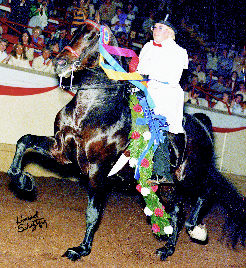
The man, the moment: Schwartz and
1984 Park Saddle World Champion
Whit-Aker’s Sensation.
Although things change, different horses and customers filter in and out of our lives, Schwartz can’t help but be thankful for the customers and horses she has had the good fortune of training, showing and putting together. With the future at hand, she is again blessed with some top stars who have graced the winner’s circle such as Sancrest Lana Jean, Jax Noble Onyx, Prairie Run Royal Thunder, Festival Honey N Spice and Qua Drangle. She continues to take her place among those top trainers who have earned their place in an industry steeped in rich tradition.
One can’t judge a book by its cover. Her quiet, shy, unassuming nature is just a mere factor of who she is. She’s a lady who knows where she’s headed, focused on the future and so thankful that the years gone by have given her the incentive to keep going. To know Kathryn Schwartz is a pleasure, to be her friend is a gift and to compete against her in the ring, you better have your game face on!
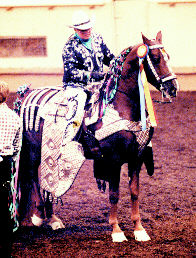
The finishing touch,
Schwartz and Heartwood Rio Grand
certainly loved to shine in the winner’s circle.
|